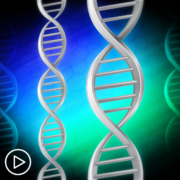AML Symptoms at Diagnosis
Dr. Daniel Pollyea reviews the criteria for an acute myeloid leukemia (AML) diagnosis, including symptoms such as fatigue, rash and anemia, and goes on to address the importance of seeking treatment quickly following a confirmed diagnosis.
Dr. Daniel Pollyea is Clinical Director of Leukemia Services in the Division of Medical Oncology, Hematologic Malignancies and Blood and Marrow Transplant at University of Colorado Cancer Center.
Related Resources

|

|
Transcript:
Ross:
How easy is it to diagnose AML?
Dr. Pollyea:
Well, I mean, I think there’s very clear diagnostic criteria for AML. But I guess that doesn’t really answer the question. And we certainly have patients who come to us after many months of frustration without a clear diagnosis.
So, those scenarios can play out. Many times AML’s a very dramatic presentation, so people get very, very sick very, very quickly with extraordinarily high white blood cell counts and suppression of all the other blood counts that come from the bone marrow like red blood cells and platelets.
In those cases it’s pretty clear that there is a type of acute leukemia going on. There can be some difficulty distinguishing Acute Myeloid from Acute Lymphoblastic Leukemia; those are sort of like cousins, but very different and treated differently. So, it kinda runs the gamut. I mean, it can be pretty clear, but it’s sometimes missed, so yeah.
Ross:
This is a great lead-in to my next question, which is about the symptoms of AML. What should be the warning signs that this might be something you need to get looked at?
Dr. Pollyea:
Right. So, at presentation, the main symptoms are reflective of the fact that the bone marrow, the organ that makes all the cells of the blood, has failed.
So, that can cause severe anemia. Signs of anemia: a white sort of appearance, feeling dizzy or lightheaded when standing, short of breath, weak, tired, fatigue. Those are all pretty clear presenting symptoms for AML. Because the bone marrow also is responsible for making platelets that clot the blood, some people will present with a bleeding complication, or a very subtle rash made up of these particular red dots. We call that a petechial rash. And that rash can come on when the platelet count gets very low.
Sometimes a person will present with an infection or infections that don’t go away or don’t clear because of decrease in white blood cells, the infection-fighting cells of the bone marrow. Those are made in the bone marrow and can fail in the setting of this disease. So, those are the most common symptoms at presentation, symptoms that are reflective of bone marrow failure.
Ross:
You mentioned that sometimes the presentation could be very dramatic, and it sounds like the symptoms are very severe, very quickly. Is that always the case? Is that often the case?
Dr. Pollyea:
That is the case in, I would say, a minority of times. That’s usually the case. It’s more often seen in younger patients with AML. Typically, older patients with AML have a more smoldering course and a much less dramatic presentation, although this sort of very dramatic and dangerous presentation can happen in older patients, but it’s probably something like a third of the time that those very dramatic and medical emergency presentations occur.
Ross:
How important is early diagnosis?
Dr. Pollyea:
Well, I mean, it’s crucial. I mean, in particular in those cases where it’s a very dramatic and proliferative diagnosis, or presentation. A quick diagnosis and recognition of this condition is very important because the sooner a person starts effective treatment the better the ultimate outcome is.
I would say in general terms that applies to all AML patients, but certainly there’s some degrees of variation. So, there’s some AML patients that when I hear about their case on the phone from a referring doctor, it’s appropriate to see them next week in the clinic.
So, it’s not always a medical emergency, but we would never, even in those next-week-in-the-clinic patients, this isn’t something that can wait for weeks or certainly months. This is something that needs to be addressed fairly quickly.










